Business Strategy Game Simulation Report: Strategic Decision Analysis
VerifiedAdded on 2022/12/14
|12
|4077
|227
Report
AI Summary
This report provides a comprehensive analysis of a Business Strategy Game (BSG) simulation, examining strategic decisions made throughout the simulation years. It identifies and evaluates key decisions, analyzing their impact on the company's performance. The report utilizes management models and concepts to assess the influence of various business environment factors, including macro, meso, and micro-environmental aspects. It also explores the implications of emerging technologies on the future competitiveness of the business and offers recommendations for future managers. The analysis covers topics such as market share, credit rating, return on equity, and stock prices. The report also incorporates PESTLE and Porter's Five Forces analyses to evaluate the external and competitive environments. The report concludes with an assessment of the company's performance and strategic adjustments made to optimize profitability and market position.
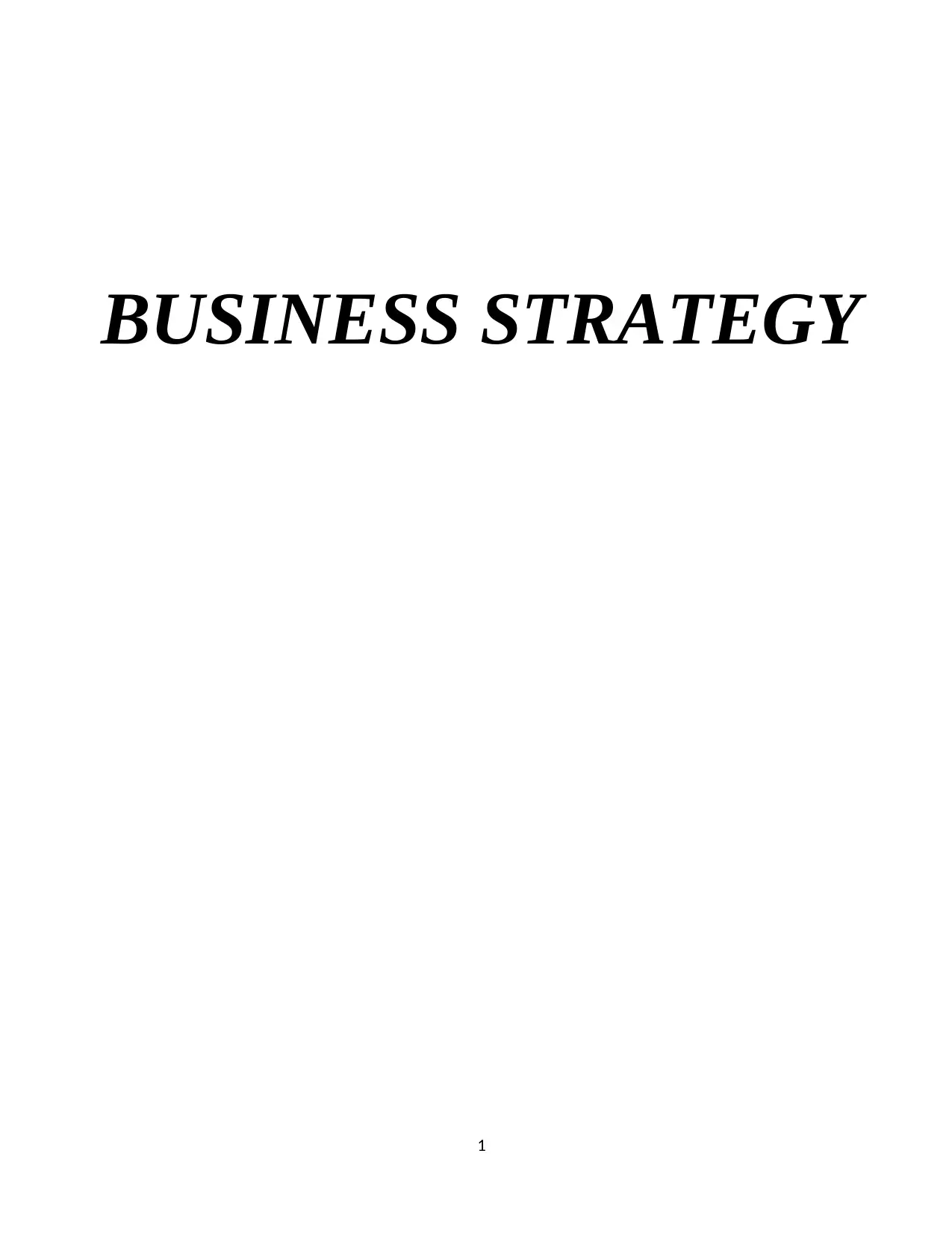
BUSINESS STRATEGY
1
1
Paraphrase This Document
Need a fresh take? Get an instant paraphrase of this document with our AI Paraphraser
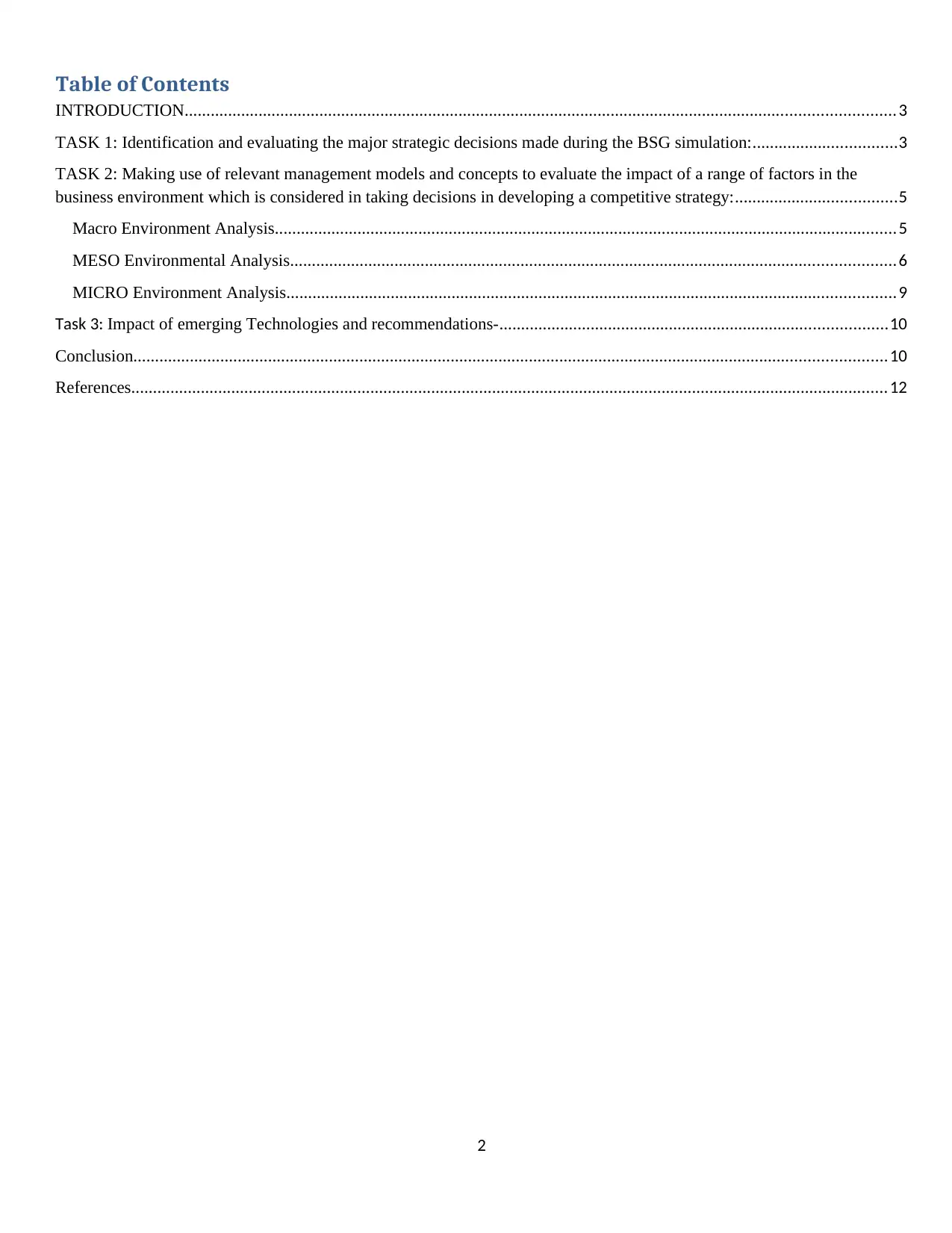
Table of Contents
INTRODUCTION................................................................................................................................................................... 3
TASK 1: Identification and evaluating the major strategic decisions made during the BSG simulation:.................................3
TASK 2: Making use of relevant management models and concepts to evaluate the impact of a range of factors in the
business environment which is considered in taking decisions in developing a competitive strategy:.....................................5
Macro Environment Analysis...............................................................................................................................................5
MESO Environmental Analysis...........................................................................................................................................6
MICRO Environment Analysis............................................................................................................................................9
Task 3: Impact of emerging Technologies and recommendations-.........................................................................................10
Conclusion.............................................................................................................................................................................10
References.............................................................................................................................................................................. 12
2
INTRODUCTION................................................................................................................................................................... 3
TASK 1: Identification and evaluating the major strategic decisions made during the BSG simulation:.................................3
TASK 2: Making use of relevant management models and concepts to evaluate the impact of a range of factors in the
business environment which is considered in taking decisions in developing a competitive strategy:.....................................5
Macro Environment Analysis...............................................................................................................................................5
MESO Environmental Analysis...........................................................................................................................................6
MICRO Environment Analysis............................................................................................................................................9
Task 3: Impact of emerging Technologies and recommendations-.........................................................................................10
Conclusion.............................................................................................................................................................................10
References.............................................................................................................................................................................. 12
2
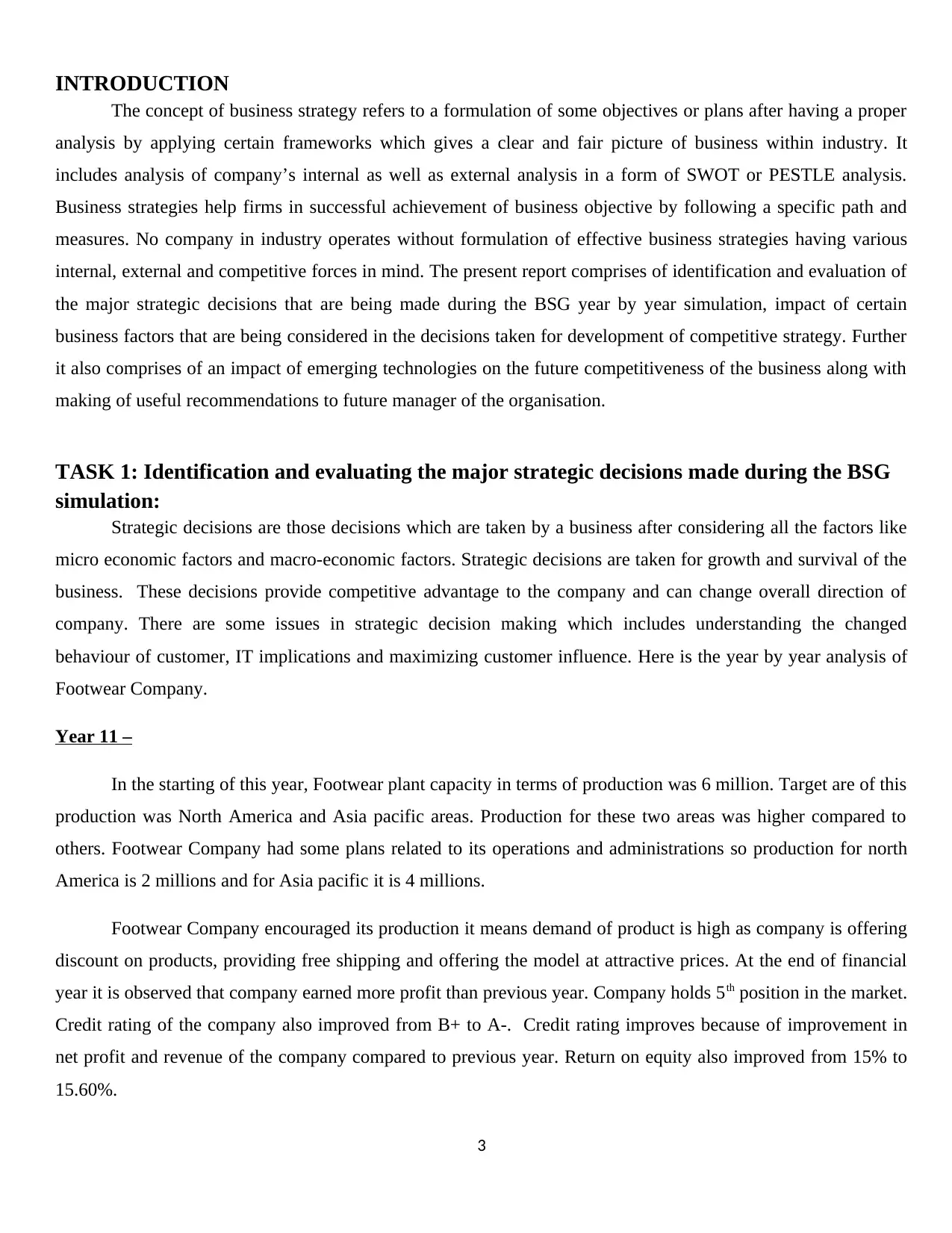
INTRODUCTION
The concept of business strategy refers to a formulation of some objectives or plans after having a proper
analysis by applying certain frameworks which gives a clear and fair picture of business within industry. It
includes analysis of company’s internal as well as external analysis in a form of SWOT or PESTLE analysis.
Business strategies help firms in successful achievement of business objective by following a specific path and
measures. No company in industry operates without formulation of effective business strategies having various
internal, external and competitive forces in mind. The present report comprises of identification and evaluation of
the major strategic decisions that are being made during the BSG year by year simulation, impact of certain
business factors that are being considered in the decisions taken for development of competitive strategy. Further
it also comprises of an impact of emerging technologies on the future competitiveness of the business along with
making of useful recommendations to future manager of the organisation.
TASK 1: Identification and evaluating the major strategic decisions made during the BSG
simulation:
Strategic decisions are those decisions which are taken by a business after considering all the factors like
micro economic factors and macro-economic factors. Strategic decisions are taken for growth and survival of the
business. These decisions provide competitive advantage to the company and can change overall direction of
company. There are some issues in strategic decision making which includes understanding the changed
behaviour of customer, IT implications and maximizing customer influence. Here is the year by year analysis of
Footwear Company.
Year 11 –
In the starting of this year, Footwear plant capacity in terms of production was 6 million. Target are of this
production was North America and Asia pacific areas. Production for these two areas was higher compared to
others. Footwear Company had some plans related to its operations and administrations so production for north
America is 2 millions and for Asia pacific it is 4 millions.
Footwear Company encouraged its production it means demand of product is high as company is offering
discount on products, providing free shipping and offering the model at attractive prices. At the end of financial
year it is observed that company earned more profit than previous year. Company holds 5th position in the market.
Credit rating of the company also improved from B+ to A-. Credit rating improves because of improvement in
net profit and revenue of the company compared to previous year. Return on equity also improved from 15% to
15.60%.
3
The concept of business strategy refers to a formulation of some objectives or plans after having a proper
analysis by applying certain frameworks which gives a clear and fair picture of business within industry. It
includes analysis of company’s internal as well as external analysis in a form of SWOT or PESTLE analysis.
Business strategies help firms in successful achievement of business objective by following a specific path and
measures. No company in industry operates without formulation of effective business strategies having various
internal, external and competitive forces in mind. The present report comprises of identification and evaluation of
the major strategic decisions that are being made during the BSG year by year simulation, impact of certain
business factors that are being considered in the decisions taken for development of competitive strategy. Further
it also comprises of an impact of emerging technologies on the future competitiveness of the business along with
making of useful recommendations to future manager of the organisation.
TASK 1: Identification and evaluating the major strategic decisions made during the BSG
simulation:
Strategic decisions are those decisions which are taken by a business after considering all the factors like
micro economic factors and macro-economic factors. Strategic decisions are taken for growth and survival of the
business. These decisions provide competitive advantage to the company and can change overall direction of
company. There are some issues in strategic decision making which includes understanding the changed
behaviour of customer, IT implications and maximizing customer influence. Here is the year by year analysis of
Footwear Company.
Year 11 –
In the starting of this year, Footwear plant capacity in terms of production was 6 million. Target are of this
production was North America and Asia pacific areas. Production for these two areas was higher compared to
others. Footwear Company had some plans related to its operations and administrations so production for north
America is 2 millions and for Asia pacific it is 4 millions.
Footwear Company encouraged its production it means demand of product is high as company is offering
discount on products, providing free shipping and offering the model at attractive prices. At the end of financial
year it is observed that company earned more profit than previous year. Company holds 5th position in the market.
Credit rating of the company also improved from B+ to A-. Credit rating improves because of improvement in
net profit and revenue of the company compared to previous year. Return on equity also improved from 15% to
15.60%.
3
⊘ This is a preview!⊘
Do you want full access?
Subscribe today to unlock all pages.

Trusted by 1+ million students worldwide
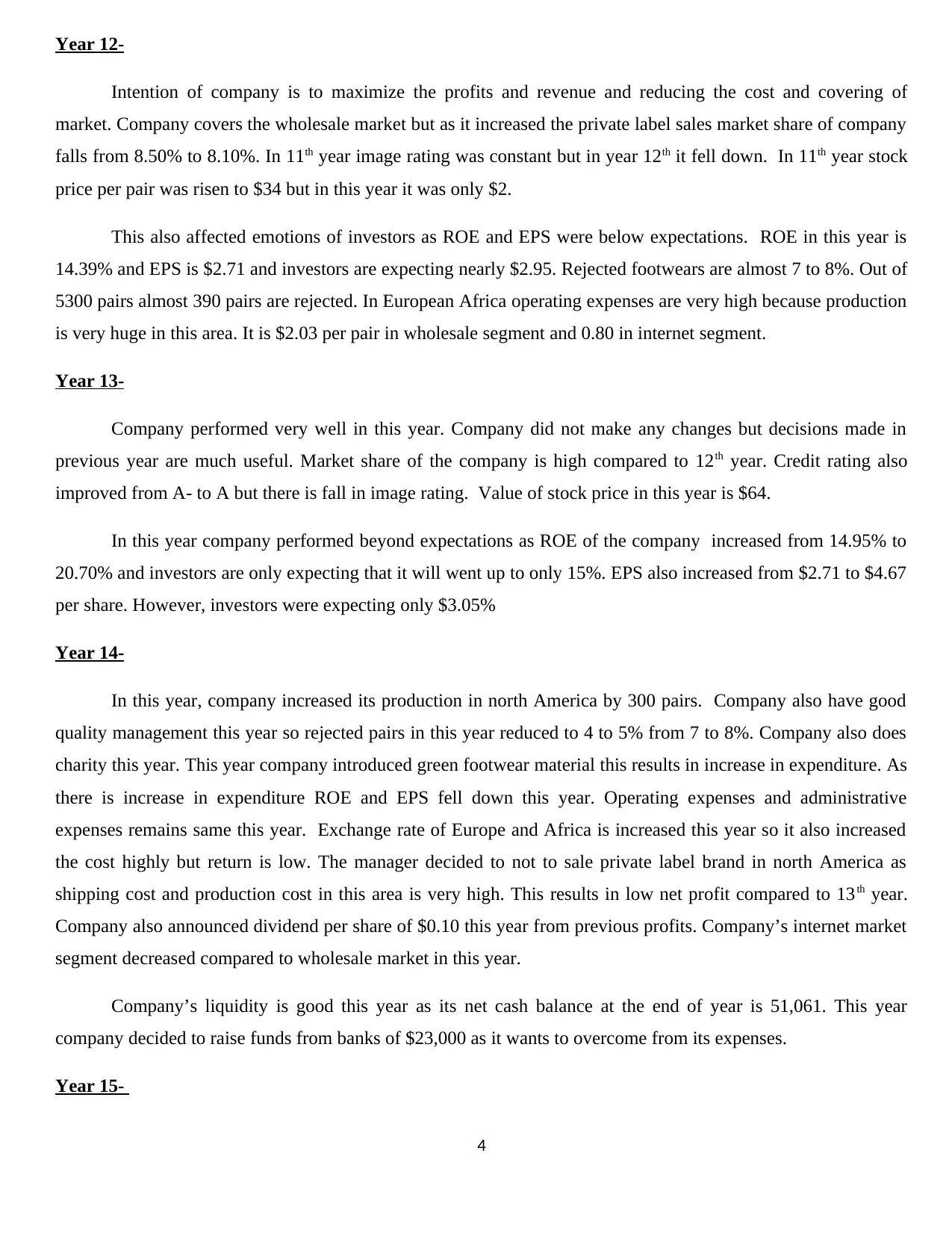
Year 12-
Intention of company is to maximize the profits and revenue and reducing the cost and covering of
market. Company covers the wholesale market but as it increased the private label sales market share of company
falls from 8.50% to 8.10%. In 11th year image rating was constant but in year 12th it fell down. In 11th year stock
price per pair was risen to $34 but in this year it was only $2.
This also affected emotions of investors as ROE and EPS were below expectations. ROE in this year is
14.39% and EPS is $2.71 and investors are expecting nearly $2.95. Rejected footwears are almost 7 to 8%. Out of
5300 pairs almost 390 pairs are rejected. In European Africa operating expenses are very high because production
is very huge in this area. It is $2.03 per pair in wholesale segment and 0.80 in internet segment.
Year 13-
Company performed very well in this year. Company did not make any changes but decisions made in
previous year are much useful. Market share of the company is high compared to 12th year. Credit rating also
improved from A- to A but there is fall in image rating. Value of stock price in this year is $64.
In this year company performed beyond expectations as ROE of the company increased from 14.95% to
20.70% and investors are only expecting that it will went up to only 15%. EPS also increased from $2.71 to $4.67
per share. However, investors were expecting only $3.05%
Year 14-
In this year, company increased its production in north America by 300 pairs. Company also have good
quality management this year so rejected pairs in this year reduced to 4 to 5% from 7 to 8%. Company also does
charity this year. This year company introduced green footwear material this results in increase in expenditure. As
there is increase in expenditure ROE and EPS fell down this year. Operating expenses and administrative
expenses remains same this year. Exchange rate of Europe and Africa is increased this year so it also increased
the cost highly but return is low. The manager decided to not to sale private label brand in north America as
shipping cost and production cost in this area is very high. This results in low net profit compared to 13th year.
Company also announced dividend per share of $0.10 this year from previous profits. Company’s internet market
segment decreased compared to wholesale market in this year.
Company’s liquidity is good this year as its net cash balance at the end of year is 51,061. This year
company decided to raise funds from banks of $23,000 as it wants to overcome from its expenses.
Year 15-
4
Intention of company is to maximize the profits and revenue and reducing the cost and covering of
market. Company covers the wholesale market but as it increased the private label sales market share of company
falls from 8.50% to 8.10%. In 11th year image rating was constant but in year 12th it fell down. In 11th year stock
price per pair was risen to $34 but in this year it was only $2.
This also affected emotions of investors as ROE and EPS were below expectations. ROE in this year is
14.39% and EPS is $2.71 and investors are expecting nearly $2.95. Rejected footwears are almost 7 to 8%. Out of
5300 pairs almost 390 pairs are rejected. In European Africa operating expenses are very high because production
is very huge in this area. It is $2.03 per pair in wholesale segment and 0.80 in internet segment.
Year 13-
Company performed very well in this year. Company did not make any changes but decisions made in
previous year are much useful. Market share of the company is high compared to 12th year. Credit rating also
improved from A- to A but there is fall in image rating. Value of stock price in this year is $64.
In this year company performed beyond expectations as ROE of the company increased from 14.95% to
20.70% and investors are only expecting that it will went up to only 15%. EPS also increased from $2.71 to $4.67
per share. However, investors were expecting only $3.05%
Year 14-
In this year, company increased its production in north America by 300 pairs. Company also have good
quality management this year so rejected pairs in this year reduced to 4 to 5% from 7 to 8%. Company also does
charity this year. This year company introduced green footwear material this results in increase in expenditure. As
there is increase in expenditure ROE and EPS fell down this year. Operating expenses and administrative
expenses remains same this year. Exchange rate of Europe and Africa is increased this year so it also increased
the cost highly but return is low. The manager decided to not to sale private label brand in north America as
shipping cost and production cost in this area is very high. This results in low net profit compared to 13th year.
Company also announced dividend per share of $0.10 this year from previous profits. Company’s internet market
segment decreased compared to wholesale market in this year.
Company’s liquidity is good this year as its net cash balance at the end of year is 51,061. This year
company decided to raise funds from banks of $23,000 as it wants to overcome from its expenses.
Year 15-
4
Paraphrase This Document
Need a fresh take? Get an instant paraphrase of this document with our AI Paraphraser
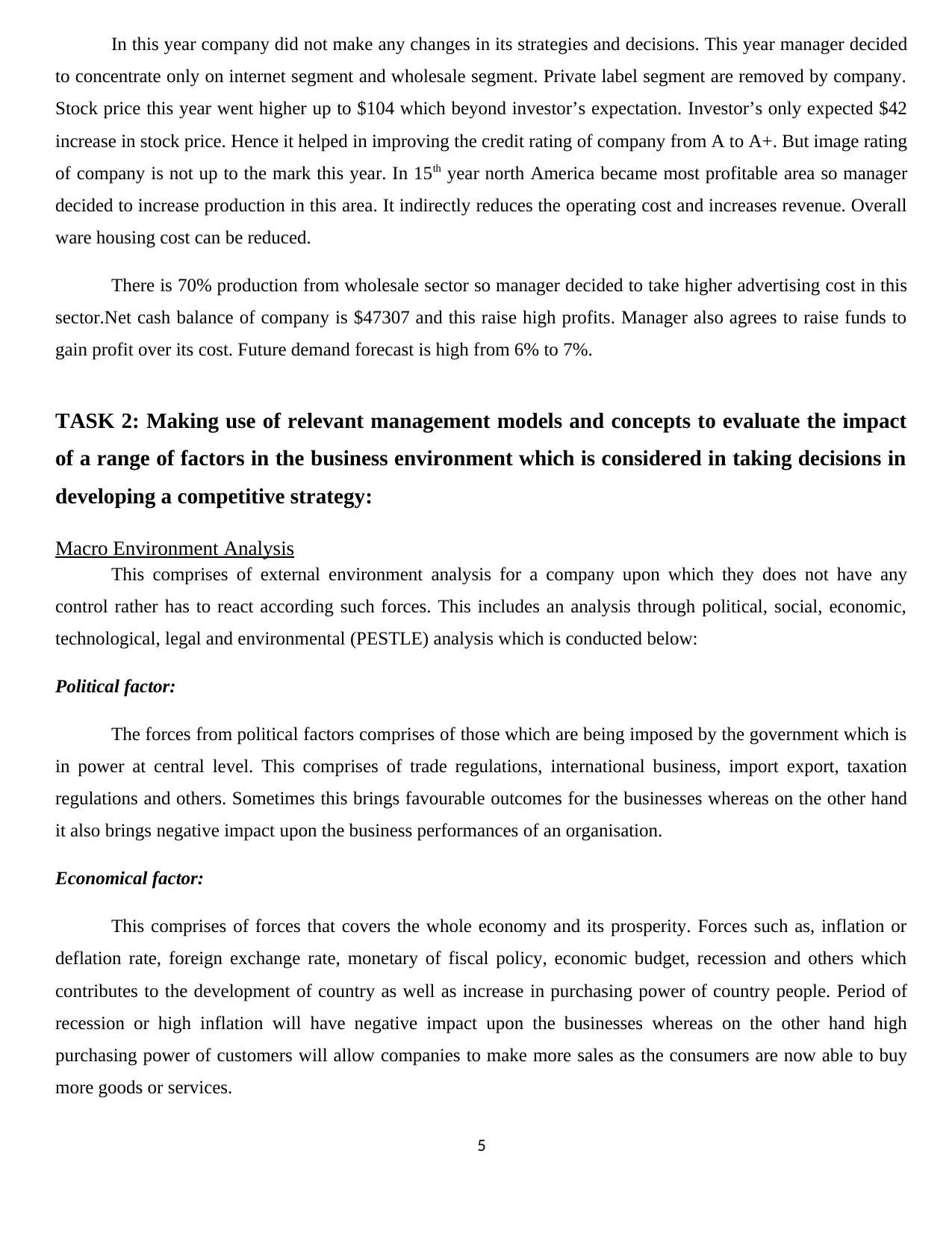
In this year company did not make any changes in its strategies and decisions. This year manager decided
to concentrate only on internet segment and wholesale segment. Private label segment are removed by company.
Stock price this year went higher up to $104 which beyond investor’s expectation. Investor’s only expected $42
increase in stock price. Hence it helped in improving the credit rating of company from A to A+. But image rating
of company is not up to the mark this year. In 15th year north America became most profitable area so manager
decided to increase production in this area. It indirectly reduces the operating cost and increases revenue. Overall
ware housing cost can be reduced.
There is 70% production from wholesale sector so manager decided to take higher advertising cost in this
sector.Net cash balance of company is $47307 and this raise high profits. Manager also agrees to raise funds to
gain profit over its cost. Future demand forecast is high from 6% to 7%.
TASK 2: Making use of relevant management models and concepts to evaluate the impact
of a range of factors in the business environment which is considered in taking decisions in
developing a competitive strategy:
Macro Environment Analysis
This comprises of external environment analysis for a company upon which they does not have any
control rather has to react according such forces. This includes an analysis through political, social, economic,
technological, legal and environmental (PESTLE) analysis which is conducted below:
Political factor:
The forces from political factors comprises of those which are being imposed by the government which is
in power at central level. This comprises of trade regulations, international business, import export, taxation
regulations and others. Sometimes this brings favourable outcomes for the businesses whereas on the other hand
it also brings negative impact upon the business performances of an organisation.
Economical factor:
This comprises of forces that covers the whole economy and its prosperity. Forces such as, inflation or
deflation rate, foreign exchange rate, monetary of fiscal policy, economic budget, recession and others which
contributes to the development of country as well as increase in purchasing power of country people. Period of
recession or high inflation will have negative impact upon the businesses whereas on the other hand high
purchasing power of customers will allow companies to make more sales as the consumers are now able to buy
more goods or services.
5
to concentrate only on internet segment and wholesale segment. Private label segment are removed by company.
Stock price this year went higher up to $104 which beyond investor’s expectation. Investor’s only expected $42
increase in stock price. Hence it helped in improving the credit rating of company from A to A+. But image rating
of company is not up to the mark this year. In 15th year north America became most profitable area so manager
decided to increase production in this area. It indirectly reduces the operating cost and increases revenue. Overall
ware housing cost can be reduced.
There is 70% production from wholesale sector so manager decided to take higher advertising cost in this
sector.Net cash balance of company is $47307 and this raise high profits. Manager also agrees to raise funds to
gain profit over its cost. Future demand forecast is high from 6% to 7%.
TASK 2: Making use of relevant management models and concepts to evaluate the impact
of a range of factors in the business environment which is considered in taking decisions in
developing a competitive strategy:
Macro Environment Analysis
This comprises of external environment analysis for a company upon which they does not have any
control rather has to react according such forces. This includes an analysis through political, social, economic,
technological, legal and environmental (PESTLE) analysis which is conducted below:
Political factor:
The forces from political factors comprises of those which are being imposed by the government which is
in power at central level. This comprises of trade regulations, international business, import export, taxation
regulations and others. Sometimes this brings favourable outcomes for the businesses whereas on the other hand
it also brings negative impact upon the business performances of an organisation.
Economical factor:
This comprises of forces that covers the whole economy and its prosperity. Forces such as, inflation or
deflation rate, foreign exchange rate, monetary of fiscal policy, economic budget, recession and others which
contributes to the development of country as well as increase in purchasing power of country people. Period of
recession or high inflation will have negative impact upon the businesses whereas on the other hand high
purchasing power of customers will allow companies to make more sales as the consumers are now able to buy
more goods or services.
5
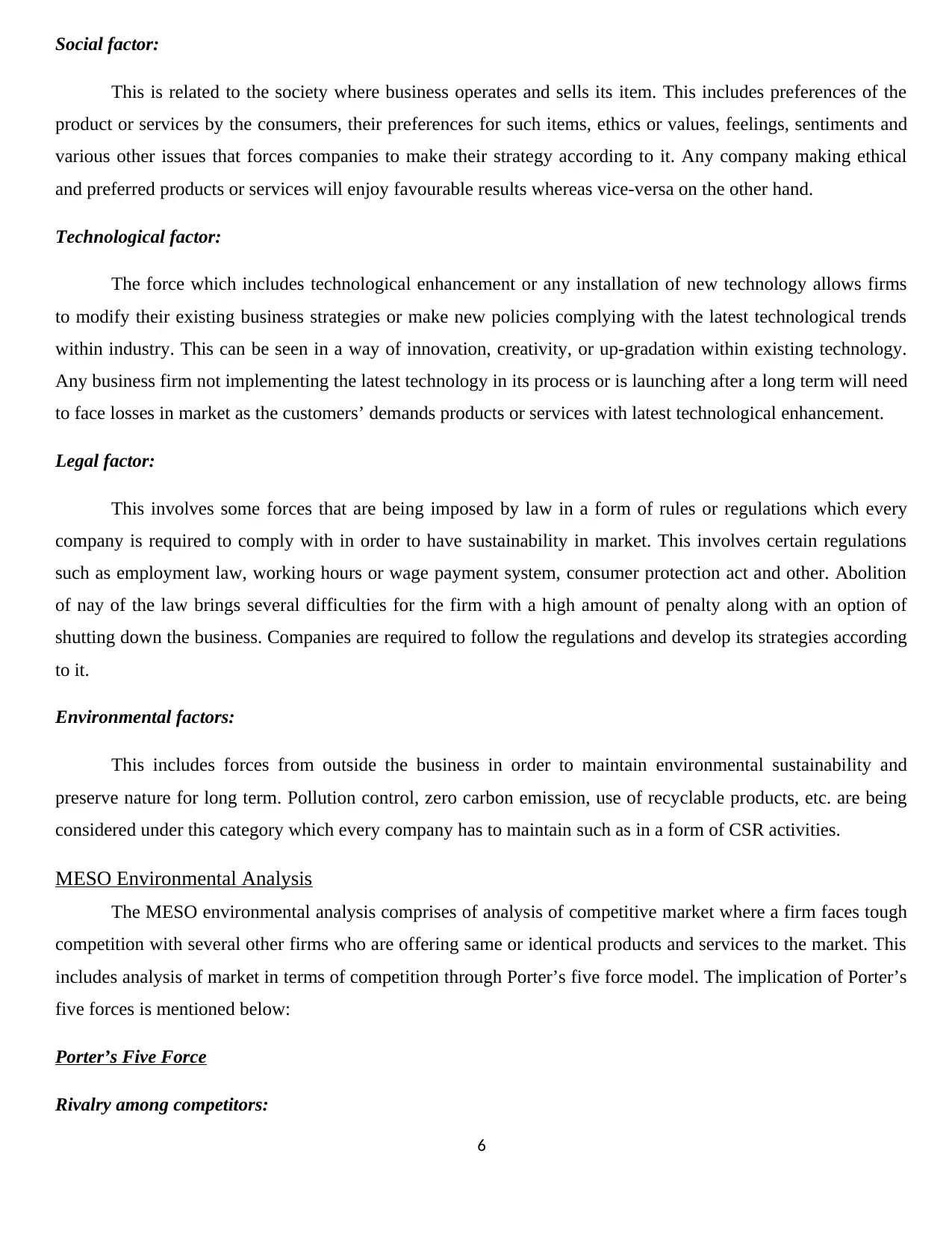
Social factor:
This is related to the society where business operates and sells its item. This includes preferences of the
product or services by the consumers, their preferences for such items, ethics or values, feelings, sentiments and
various other issues that forces companies to make their strategy according to it. Any company making ethical
and preferred products or services will enjoy favourable results whereas vice-versa on the other hand.
Technological factor:
The force which includes technological enhancement or any installation of new technology allows firms
to modify their existing business strategies or make new policies complying with the latest technological trends
within industry. This can be seen in a way of innovation, creativity, or up-gradation within existing technology.
Any business firm not implementing the latest technology in its process or is launching after a long term will need
to face losses in market as the customers’ demands products or services with latest technological enhancement.
Legal factor:
This involves some forces that are being imposed by law in a form of rules or regulations which every
company is required to comply with in order to have sustainability in market. This involves certain regulations
such as employment law, working hours or wage payment system, consumer protection act and other. Abolition
of nay of the law brings several difficulties for the firm with a high amount of penalty along with an option of
shutting down the business. Companies are required to follow the regulations and develop its strategies according
to it.
Environmental factors:
This includes forces from outside the business in order to maintain environmental sustainability and
preserve nature for long term. Pollution control, zero carbon emission, use of recyclable products, etc. are being
considered under this category which every company has to maintain such as in a form of CSR activities.
MESO Environmental Analysis
The MESO environmental analysis comprises of analysis of competitive market where a firm faces tough
competition with several other firms who are offering same or identical products and services to the market. This
includes analysis of market in terms of competition through Porter’s five force model. The implication of Porter’s
five forces is mentioned below:
Porter’s Five Force
Rivalry among competitors:
6
This is related to the society where business operates and sells its item. This includes preferences of the
product or services by the consumers, their preferences for such items, ethics or values, feelings, sentiments and
various other issues that forces companies to make their strategy according to it. Any company making ethical
and preferred products or services will enjoy favourable results whereas vice-versa on the other hand.
Technological factor:
The force which includes technological enhancement or any installation of new technology allows firms
to modify their existing business strategies or make new policies complying with the latest technological trends
within industry. This can be seen in a way of innovation, creativity, or up-gradation within existing technology.
Any business firm not implementing the latest technology in its process or is launching after a long term will need
to face losses in market as the customers’ demands products or services with latest technological enhancement.
Legal factor:
This involves some forces that are being imposed by law in a form of rules or regulations which every
company is required to comply with in order to have sustainability in market. This involves certain regulations
such as employment law, working hours or wage payment system, consumer protection act and other. Abolition
of nay of the law brings several difficulties for the firm with a high amount of penalty along with an option of
shutting down the business. Companies are required to follow the regulations and develop its strategies according
to it.
Environmental factors:
This includes forces from outside the business in order to maintain environmental sustainability and
preserve nature for long term. Pollution control, zero carbon emission, use of recyclable products, etc. are being
considered under this category which every company has to maintain such as in a form of CSR activities.
MESO Environmental Analysis
The MESO environmental analysis comprises of analysis of competitive market where a firm faces tough
competition with several other firms who are offering same or identical products and services to the market. This
includes analysis of market in terms of competition through Porter’s five force model. The implication of Porter’s
five forces is mentioned below:
Porter’s Five Force
Rivalry among competitors:
6
⊘ This is a preview!⊘
Do you want full access?
Subscribe today to unlock all pages.

Trusted by 1+ million students worldwide
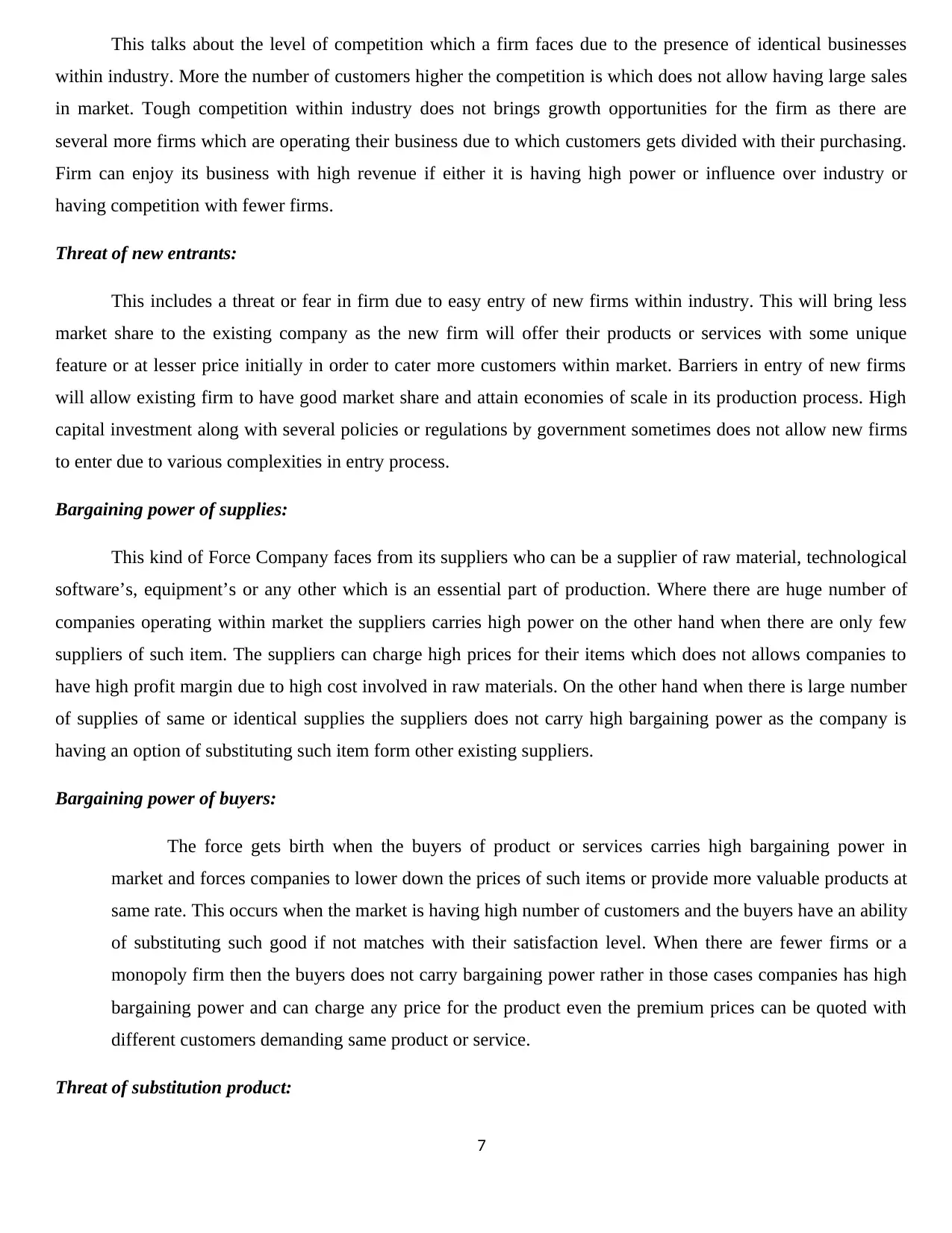
This talks about the level of competition which a firm faces due to the presence of identical businesses
within industry. More the number of customers higher the competition is which does not allow having large sales
in market. Tough competition within industry does not brings growth opportunities for the firm as there are
several more firms which are operating their business due to which customers gets divided with their purchasing.
Firm can enjoy its business with high revenue if either it is having high power or influence over industry or
having competition with fewer firms.
Threat of new entrants:
This includes a threat or fear in firm due to easy entry of new firms within industry. This will bring less
market share to the existing company as the new firm will offer their products or services with some unique
feature or at lesser price initially in order to cater more customers within market. Barriers in entry of new firms
will allow existing firm to have good market share and attain economies of scale in its production process. High
capital investment along with several policies or regulations by government sometimes does not allow new firms
to enter due to various complexities in entry process.
Bargaining power of supplies:
This kind of Force Company faces from its suppliers who can be a supplier of raw material, technological
software’s, equipment’s or any other which is an essential part of production. Where there are huge number of
companies operating within market the suppliers carries high power on the other hand when there are only few
suppliers of such item. The suppliers can charge high prices for their items which does not allows companies to
have high profit margin due to high cost involved in raw materials. On the other hand when there is large number
of supplies of same or identical supplies the suppliers does not carry high bargaining power as the company is
having an option of substituting such item form other existing suppliers.
Bargaining power of buyers:
The force gets birth when the buyers of product or services carries high bargaining power in
market and forces companies to lower down the prices of such items or provide more valuable products at
same rate. This occurs when the market is having high number of customers and the buyers have an ability
of substituting such good if not matches with their satisfaction level. When there are fewer firms or a
monopoly firm then the buyers does not carry bargaining power rather in those cases companies has high
bargaining power and can charge any price for the product even the premium prices can be quoted with
different customers demanding same product or service.
Threat of substitution product:
7
within industry. More the number of customers higher the competition is which does not allow having large sales
in market. Tough competition within industry does not brings growth opportunities for the firm as there are
several more firms which are operating their business due to which customers gets divided with their purchasing.
Firm can enjoy its business with high revenue if either it is having high power or influence over industry or
having competition with fewer firms.
Threat of new entrants:
This includes a threat or fear in firm due to easy entry of new firms within industry. This will bring less
market share to the existing company as the new firm will offer their products or services with some unique
feature or at lesser price initially in order to cater more customers within market. Barriers in entry of new firms
will allow existing firm to have good market share and attain economies of scale in its production process. High
capital investment along with several policies or regulations by government sometimes does not allow new firms
to enter due to various complexities in entry process.
Bargaining power of supplies:
This kind of Force Company faces from its suppliers who can be a supplier of raw material, technological
software’s, equipment’s or any other which is an essential part of production. Where there are huge number of
companies operating within market the suppliers carries high power on the other hand when there are only few
suppliers of such item. The suppliers can charge high prices for their items which does not allows companies to
have high profit margin due to high cost involved in raw materials. On the other hand when there is large number
of supplies of same or identical supplies the suppliers does not carry high bargaining power as the company is
having an option of substituting such item form other existing suppliers.
Bargaining power of buyers:
The force gets birth when the buyers of product or services carries high bargaining power in
market and forces companies to lower down the prices of such items or provide more valuable products at
same rate. This occurs when the market is having high number of customers and the buyers have an ability
of substituting such good if not matches with their satisfaction level. When there are fewer firms or a
monopoly firm then the buyers does not carry bargaining power rather in those cases companies has high
bargaining power and can charge any price for the product even the premium prices can be quoted with
different customers demanding same product or service.
Threat of substitution product:
7
Paraphrase This Document
Need a fresh take? Get an instant paraphrase of this document with our AI Paraphraser
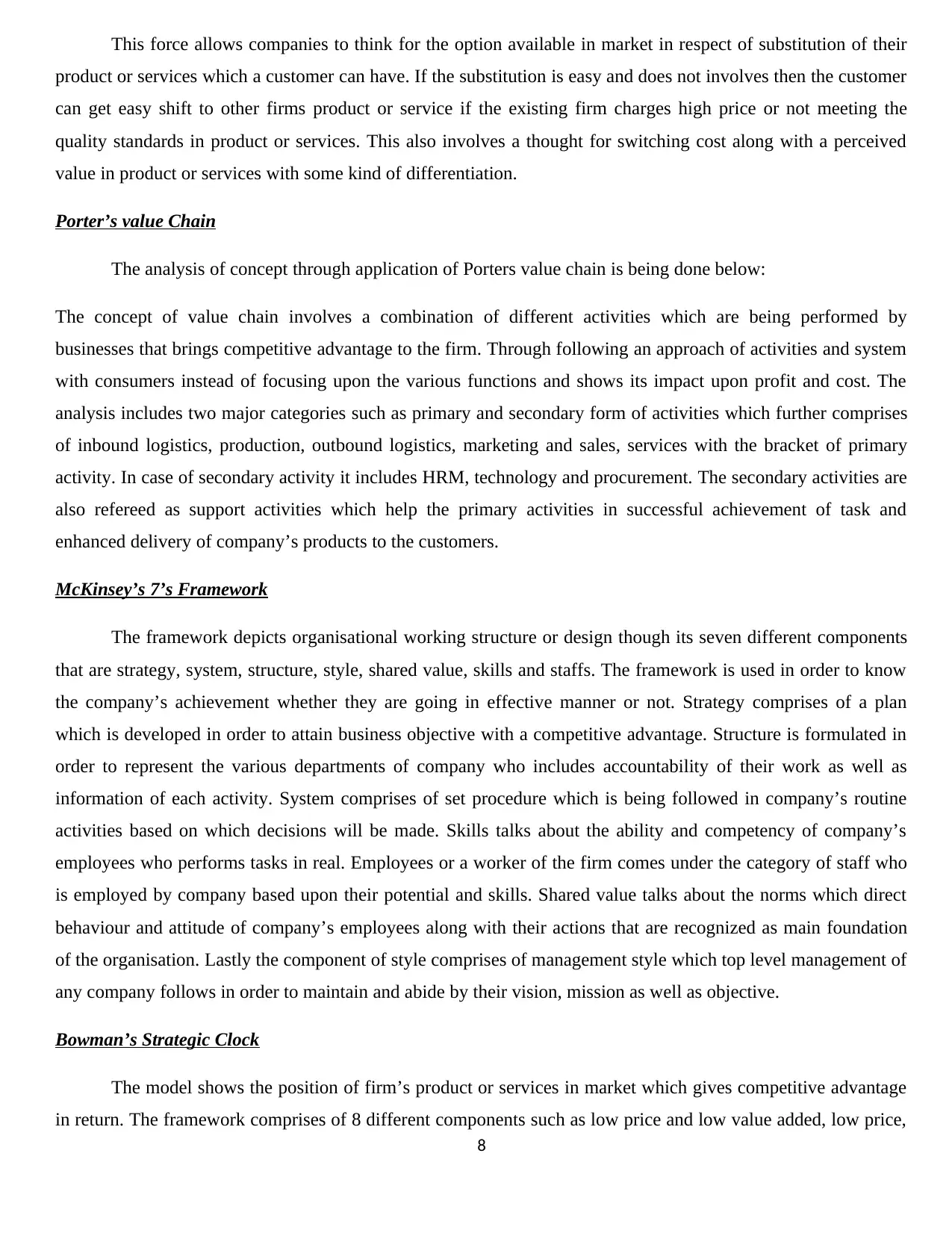
This force allows companies to think for the option available in market in respect of substitution of their
product or services which a customer can have. If the substitution is easy and does not involves then the customer
can get easy shift to other firms product or service if the existing firm charges high price or not meeting the
quality standards in product or services. This also involves a thought for switching cost along with a perceived
value in product or services with some kind of differentiation.
Porter’s value Chain
The analysis of concept through application of Porters value chain is being done below:
The concept of value chain involves a combination of different activities which are being performed by
businesses that brings competitive advantage to the firm. Through following an approach of activities and system
with consumers instead of focusing upon the various functions and shows its impact upon profit and cost. The
analysis includes two major categories such as primary and secondary form of activities which further comprises
of inbound logistics, production, outbound logistics, marketing and sales, services with the bracket of primary
activity. In case of secondary activity it includes HRM, technology and procurement. The secondary activities are
also refereed as support activities which help the primary activities in successful achievement of task and
enhanced delivery of company’s products to the customers.
McKinsey’s 7’s Framework
The framework depicts organisational working structure or design though its seven different components
that are strategy, system, structure, style, shared value, skills and staffs. The framework is used in order to know
the company’s achievement whether they are going in effective manner or not. Strategy comprises of a plan
which is developed in order to attain business objective with a competitive advantage. Structure is formulated in
order to represent the various departments of company who includes accountability of their work as well as
information of each activity. System comprises of set procedure which is being followed in company’s routine
activities based on which decisions will be made. Skills talks about the ability and competency of company’s
employees who performs tasks in real. Employees or a worker of the firm comes under the category of staff who
is employed by company based upon their potential and skills. Shared value talks about the norms which direct
behaviour and attitude of company’s employees along with their actions that are recognized as main foundation
of the organisation. Lastly the component of style comprises of management style which top level management of
any company follows in order to maintain and abide by their vision, mission as well as objective.
Bowman’s Strategic Clock
The model shows the position of firm’s product or services in market which gives competitive advantage
in return. The framework comprises of 8 different components such as low price and low value added, low price,
8
product or services which a customer can have. If the substitution is easy and does not involves then the customer
can get easy shift to other firms product or service if the existing firm charges high price or not meeting the
quality standards in product or services. This also involves a thought for switching cost along with a perceived
value in product or services with some kind of differentiation.
Porter’s value Chain
The analysis of concept through application of Porters value chain is being done below:
The concept of value chain involves a combination of different activities which are being performed by
businesses that brings competitive advantage to the firm. Through following an approach of activities and system
with consumers instead of focusing upon the various functions and shows its impact upon profit and cost. The
analysis includes two major categories such as primary and secondary form of activities which further comprises
of inbound logistics, production, outbound logistics, marketing and sales, services with the bracket of primary
activity. In case of secondary activity it includes HRM, technology and procurement. The secondary activities are
also refereed as support activities which help the primary activities in successful achievement of task and
enhanced delivery of company’s products to the customers.
McKinsey’s 7’s Framework
The framework depicts organisational working structure or design though its seven different components
that are strategy, system, structure, style, shared value, skills and staffs. The framework is used in order to know
the company’s achievement whether they are going in effective manner or not. Strategy comprises of a plan
which is developed in order to attain business objective with a competitive advantage. Structure is formulated in
order to represent the various departments of company who includes accountability of their work as well as
information of each activity. System comprises of set procedure which is being followed in company’s routine
activities based on which decisions will be made. Skills talks about the ability and competency of company’s
employees who performs tasks in real. Employees or a worker of the firm comes under the category of staff who
is employed by company based upon their potential and skills. Shared value talks about the norms which direct
behaviour and attitude of company’s employees along with their actions that are recognized as main foundation
of the organisation. Lastly the component of style comprises of management style which top level management of
any company follows in order to maintain and abide by their vision, mission as well as objective.
Bowman’s Strategic Clock
The model shows the position of firm’s product or services in market which gives competitive advantage
in return. The framework comprises of 8 different components such as low price and low value added, low price,
8
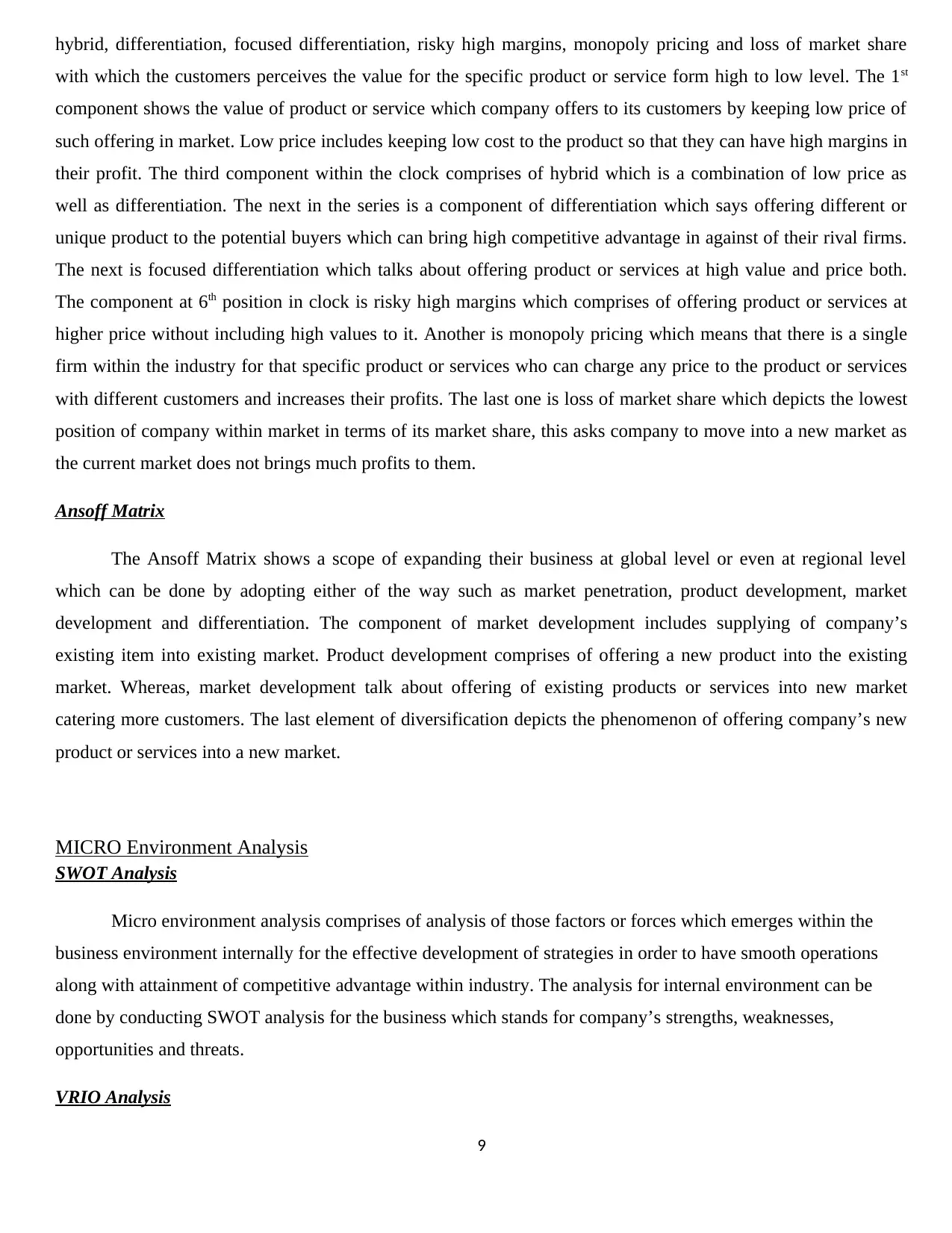
hybrid, differentiation, focused differentiation, risky high margins, monopoly pricing and loss of market share
with which the customers perceives the value for the specific product or service form high to low level. The 1st
component shows the value of product or service which company offers to its customers by keeping low price of
such offering in market. Low price includes keeping low cost to the product so that they can have high margins in
their profit. The third component within the clock comprises of hybrid which is a combination of low price as
well as differentiation. The next in the series is a component of differentiation which says offering different or
unique product to the potential buyers which can bring high competitive advantage in against of their rival firms.
The next is focused differentiation which talks about offering product or services at high value and price both.
The component at 6th position in clock is risky high margins which comprises of offering product or services at
higher price without including high values to it. Another is monopoly pricing which means that there is a single
firm within the industry for that specific product or services who can charge any price to the product or services
with different customers and increases their profits. The last one is loss of market share which depicts the lowest
position of company within market in terms of its market share, this asks company to move into a new market as
the current market does not brings much profits to them.
Ansoff Matrix
The Ansoff Matrix shows a scope of expanding their business at global level or even at regional level
which can be done by adopting either of the way such as market penetration, product development, market
development and differentiation. The component of market development includes supplying of company’s
existing item into existing market. Product development comprises of offering a new product into the existing
market. Whereas, market development talk about offering of existing products or services into new market
catering more customers. The last element of diversification depicts the phenomenon of offering company’s new
product or services into a new market.
MICRO Environment Analysis
SWOT Analysis
Micro environment analysis comprises of analysis of those factors or forces which emerges within the
business environment internally for the effective development of strategies in order to have smooth operations
along with attainment of competitive advantage within industry. The analysis for internal environment can be
done by conducting SWOT analysis for the business which stands for company’s strengths, weaknesses,
opportunities and threats.
VRIO Analysis
9
with which the customers perceives the value for the specific product or service form high to low level. The 1st
component shows the value of product or service which company offers to its customers by keeping low price of
such offering in market. Low price includes keeping low cost to the product so that they can have high margins in
their profit. The third component within the clock comprises of hybrid which is a combination of low price as
well as differentiation. The next in the series is a component of differentiation which says offering different or
unique product to the potential buyers which can bring high competitive advantage in against of their rival firms.
The next is focused differentiation which talks about offering product or services at high value and price both.
The component at 6th position in clock is risky high margins which comprises of offering product or services at
higher price without including high values to it. Another is monopoly pricing which means that there is a single
firm within the industry for that specific product or services who can charge any price to the product or services
with different customers and increases their profits. The last one is loss of market share which depicts the lowest
position of company within market in terms of its market share, this asks company to move into a new market as
the current market does not brings much profits to them.
Ansoff Matrix
The Ansoff Matrix shows a scope of expanding their business at global level or even at regional level
which can be done by adopting either of the way such as market penetration, product development, market
development and differentiation. The component of market development includes supplying of company’s
existing item into existing market. Product development comprises of offering a new product into the existing
market. Whereas, market development talk about offering of existing products or services into new market
catering more customers. The last element of diversification depicts the phenomenon of offering company’s new
product or services into a new market.
MICRO Environment Analysis
SWOT Analysis
Micro environment analysis comprises of analysis of those factors or forces which emerges within the
business environment internally for the effective development of strategies in order to have smooth operations
along with attainment of competitive advantage within industry. The analysis for internal environment can be
done by conducting SWOT analysis for the business which stands for company’s strengths, weaknesses,
opportunities and threats.
VRIO Analysis
9
⊘ This is a preview!⊘
Do you want full access?
Subscribe today to unlock all pages.

Trusted by 1+ million students worldwide
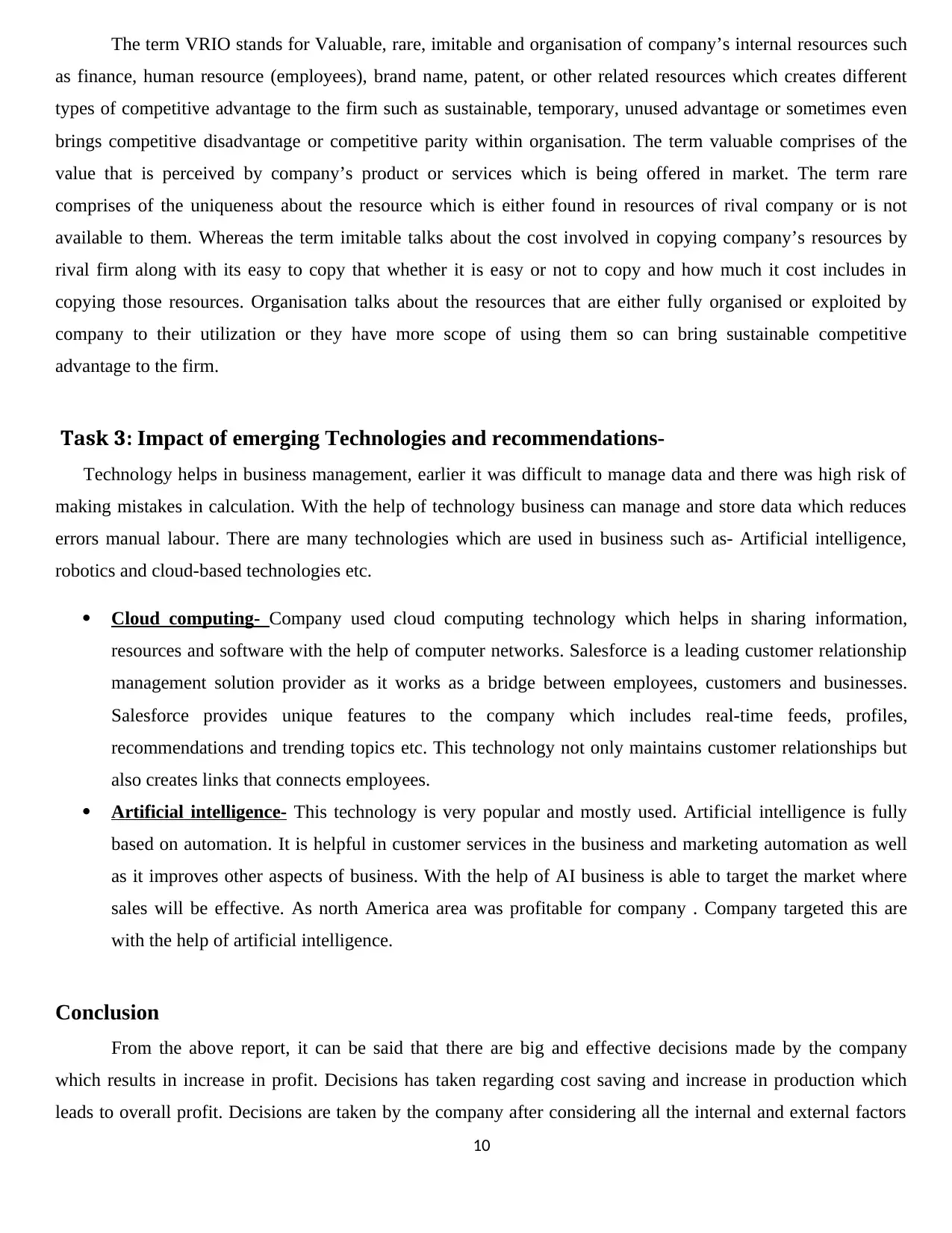
The term VRIO stands for Valuable, rare, imitable and organisation of company’s internal resources such
as finance, human resource (employees), brand name, patent, or other related resources which creates different
types of competitive advantage to the firm such as sustainable, temporary, unused advantage or sometimes even
brings competitive disadvantage or competitive parity within organisation. The term valuable comprises of the
value that is perceived by company’s product or services which is being offered in market. The term rare
comprises of the uniqueness about the resource which is either found in resources of rival company or is not
available to them. Whereas the term imitable talks about the cost involved in copying company’s resources by
rival firm along with its easy to copy that whether it is easy or not to copy and how much it cost includes in
copying those resources. Organisation talks about the resources that are either fully organised or exploited by
company to their utilization or they have more scope of using them so can bring sustainable competitive
advantage to the firm.
Task 3: Impact of emerging Technologies and recommendations-
Technology helps in business management, earlier it was difficult to manage data and there was high risk of
making mistakes in calculation. With the help of technology business can manage and store data which reduces
errors manual labour. There are many technologies which are used in business such as- Artificial intelligence,
robotics and cloud-based technologies etc.
Cloud computing- Company used cloud computing technology which helps in sharing information,
resources and software with the help of computer networks. Salesforce is a leading customer relationship
management solution provider as it works as a bridge between employees, customers and businesses.
Salesforce provides unique features to the company which includes real-time feeds, profiles,
recommendations and trending topics etc. This technology not only maintains customer relationships but
also creates links that connects employees.
Artificial intelligence- This technology is very popular and mostly used. Artificial intelligence is fully
based on automation. It is helpful in customer services in the business and marketing automation as well
as it improves other aspects of business. With the help of AI business is able to target the market where
sales will be effective. As north America area was profitable for company . Company targeted this are
with the help of artificial intelligence.
Conclusion
From the above report, it can be said that there are big and effective decisions made by the company
which results in increase in profit. Decisions has taken regarding cost saving and increase in production which
leads to overall profit. Decisions are taken by the company after considering all the internal and external factors
10
as finance, human resource (employees), brand name, patent, or other related resources which creates different
types of competitive advantage to the firm such as sustainable, temporary, unused advantage or sometimes even
brings competitive disadvantage or competitive parity within organisation. The term valuable comprises of the
value that is perceived by company’s product or services which is being offered in market. The term rare
comprises of the uniqueness about the resource which is either found in resources of rival company or is not
available to them. Whereas the term imitable talks about the cost involved in copying company’s resources by
rival firm along with its easy to copy that whether it is easy or not to copy and how much it cost includes in
copying those resources. Organisation talks about the resources that are either fully organised or exploited by
company to their utilization or they have more scope of using them so can bring sustainable competitive
advantage to the firm.
Task 3: Impact of emerging Technologies and recommendations-
Technology helps in business management, earlier it was difficult to manage data and there was high risk of
making mistakes in calculation. With the help of technology business can manage and store data which reduces
errors manual labour. There are many technologies which are used in business such as- Artificial intelligence,
robotics and cloud-based technologies etc.
Cloud computing- Company used cloud computing technology which helps in sharing information,
resources and software with the help of computer networks. Salesforce is a leading customer relationship
management solution provider as it works as a bridge between employees, customers and businesses.
Salesforce provides unique features to the company which includes real-time feeds, profiles,
recommendations and trending topics etc. This technology not only maintains customer relationships but
also creates links that connects employees.
Artificial intelligence- This technology is very popular and mostly used. Artificial intelligence is fully
based on automation. It is helpful in customer services in the business and marketing automation as well
as it improves other aspects of business. With the help of AI business is able to target the market where
sales will be effective. As north America area was profitable for company . Company targeted this are
with the help of artificial intelligence.
Conclusion
From the above report, it can be said that there are big and effective decisions made by the company
which results in increase in profit. Decisions has taken regarding cost saving and increase in production which
leads to overall profit. Decisions are taken by the company after considering all the internal and external factors
10
Paraphrase This Document
Need a fresh take? Get an instant paraphrase of this document with our AI Paraphraser
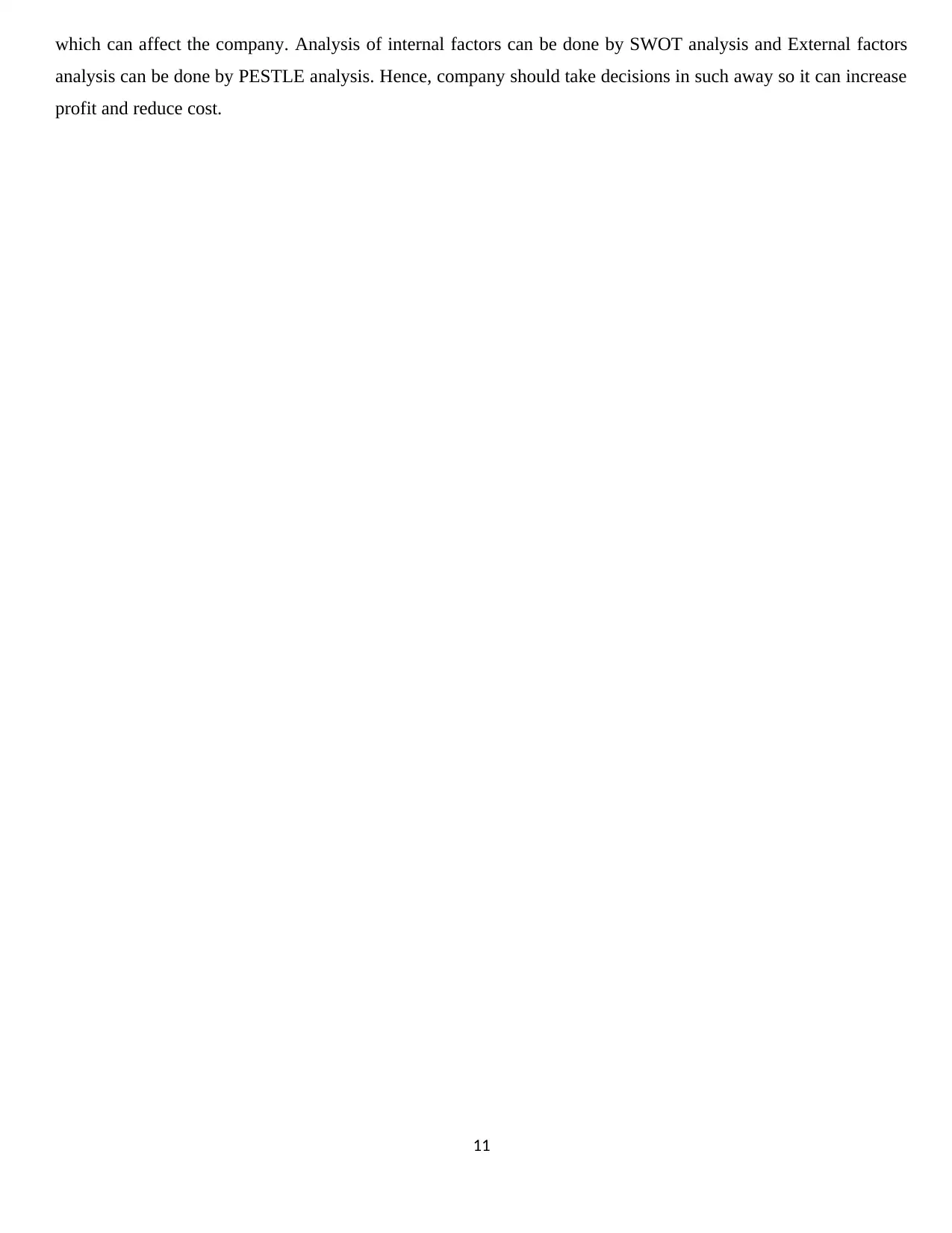
which can affect the company. Analysis of internal factors can be done by SWOT analysis and External factors
analysis can be done by PESTLE analysis. Hence, company should take decisions in such away so it can increase
profit and reduce cost.
11
analysis can be done by PESTLE analysis. Hence, company should take decisions in such away so it can increase
profit and reduce cost.
11
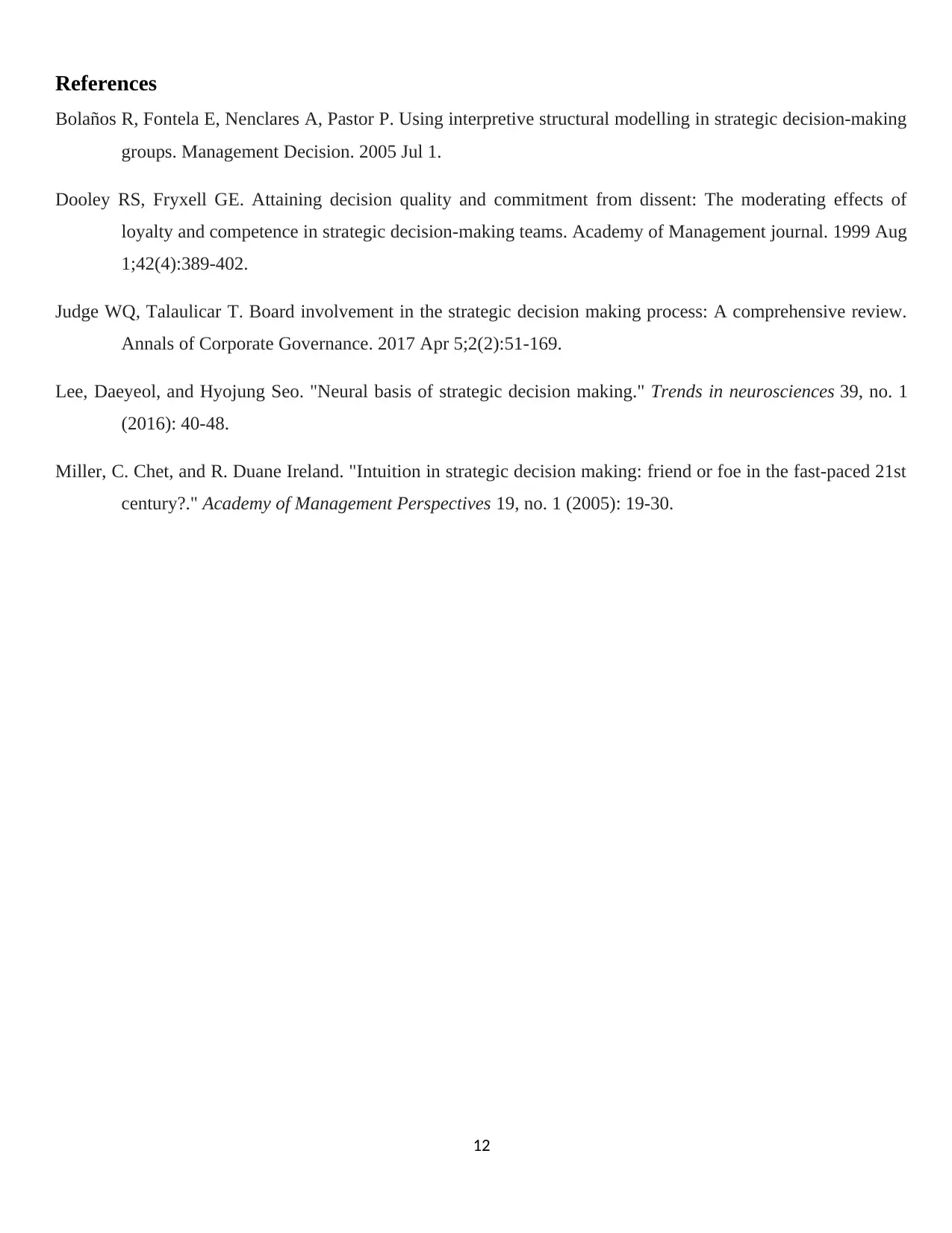
References
Bolaños R, Fontela E, Nenclares A, Pastor P. Using interpretive structural modelling in strategic decision‐making
groups. Management Decision. 2005 Jul 1.
Dooley RS, Fryxell GE. Attaining decision quality and commitment from dissent: The moderating effects of
loyalty and competence in strategic decision-making teams. Academy of Management journal. 1999 Aug
1;42(4):389-402.
Judge WQ, Talaulicar T. Board involvement in the strategic decision making process: A comprehensive review.
Annals of Corporate Governance. 2017 Apr 5;2(2):51-169.
Lee, Daeyeol, and Hyojung Seo. "Neural basis of strategic decision making." Trends in neurosciences 39, no. 1
(2016): 40-48.
Miller, C. Chet, and R. Duane Ireland. "Intuition in strategic decision making: friend or foe in the fast-paced 21st
century?." Academy of Management Perspectives 19, no. 1 (2005): 19-30.
12
Bolaños R, Fontela E, Nenclares A, Pastor P. Using interpretive structural modelling in strategic decision‐making
groups. Management Decision. 2005 Jul 1.
Dooley RS, Fryxell GE. Attaining decision quality and commitment from dissent: The moderating effects of
loyalty and competence in strategic decision-making teams. Academy of Management journal. 1999 Aug
1;42(4):389-402.
Judge WQ, Talaulicar T. Board involvement in the strategic decision making process: A comprehensive review.
Annals of Corporate Governance. 2017 Apr 5;2(2):51-169.
Lee, Daeyeol, and Hyojung Seo. "Neural basis of strategic decision making." Trends in neurosciences 39, no. 1
(2016): 40-48.
Miller, C. Chet, and R. Duane Ireland. "Intuition in strategic decision making: friend or foe in the fast-paced 21st
century?." Academy of Management Perspectives 19, no. 1 (2005): 19-30.
12
⊘ This is a preview!⊘
Do you want full access?
Subscribe today to unlock all pages.

Trusted by 1+ million students worldwide
1 out of 12
Related Documents
Your All-in-One AI-Powered Toolkit for Academic Success.
+13062052269
info@desklib.com
Available 24*7 on WhatsApp / Email
![[object Object]](/_next/static/media/star-bottom.7253800d.svg)
Unlock your academic potential
Copyright © 2020–2025 A2Z Services. All Rights Reserved. Developed and managed by ZUCOL.




